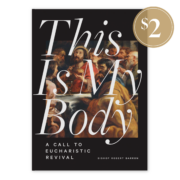This piece was originally published in the Summer 2022 “Childhood” edition of the Word on Fire Institute Journal Evangelization & Culture. Learn more and start your membership today to get your own quarterly print and online edition.
In the Bible and in the history of the Church, we often encounter children appointed to tasks that rely on their purity of heart, and result in the edification of others. From the tale of David’s defeat of Goliath to young Jesus’ teaching in the temple at Jerusalem to Our Lady of Fatima’s appearance to Lúcia, Francisco, and Jacinta, kids’ experiences are particularly valuable to God in imparting his power, truth, and mercy. As Pope St. John Paul II wrote in his “Letter to Children in the Year of the Family” in 1994, “The whole of the Gospel could actually be read as the ‘Gospel of children.’” Accordingly, over the years there has been a slew of films featuring children’s adventures. Many of these movies propose that sometimes children know better than adults, and that kids are uniquely suited to overcoming challenges that their parents either cannot or will not attempt. And no decade offered better kids’ stories than the 1980s.
In Steven Spielberg’s 1982 classic E.T. the Extra-Terrestrial, young Elliot, played by Henry Thomas, is a precocious kid from a sunny southern California suburb, and his home, like so many in which Gen-Xers were raised, is headed by a single mother. Elliot is in a standard predicament for a kid in late twentieth-century America. Despite the widespread prosperity around him, Elliot experiences a lonely ache in his soul and frustration about being misunderstood or ignored. The grown-ups in Elliot’s life are either too busy or simply too closeminded to understand his needs, let alone to believe in the existence of a space alien who needs assistance getting home.
Despite their own hurt, Elliot and his friends, unencumbered by adult concerns, find ways to demonstrate selfless compassion, even though the people who formed them in virtue are incapable of helping. And the government agents and scientists who storm Elliot’s house and attempt to dissect E.T. are prime candidates for the millstones that Jesus prescribes to those who cause “little ones” to sin (Matt. 18:6).
How do we know for sure there is no hidden treasure unless we look for it?
Elliot’s intense empathy for E.T. expresses itself in a telekinetic link between the two, famously symbolized by E.T.’s illuminated forefinger reaching out to Elliot’s small digit, but even more significantly by the alien’s glowing red heart, which inspired the Neil Diamond song, “Turn on Your Heartlight.” Here, Christians may call to mind St. Luke’s slightly nuanced presentation of Jesus’ view of true greatness. Although Matthew, Mark, and Luke all record Jesus bringing forth a child and telling his disciples “whoever receives one such child in my name receives me,” Luke alone reveals his motive, telling us that Jesus first “perceived the thoughts of their hearts.”
To Israel and the Catholic Church alike, “the heart” has been and remains the best word to describe the deepest seat of a human being’s spiritual identity. “Blessed are the pure in heart,” Jesus tells us in the Sermon on the Mount, “for they shall see God” (Matt. 5:8). And although children—with the exception of young Jesus—are sinners like the rest of us, their hearts often remain focused on the wonder of God’s goodness, whereas spiritual myopia too often overcomes adults’ hearts. Fr. Luigi Giussani, the founder of the Communion and Liberation movement, writes, “I identify this heart with what I have called elementary experience . . . the original impetus with which the human being reaches out to reality.” As we see in E.T., it is sometimes what the grown-up heart dismisses as unreal that children unfailingly identify as essential. And ironically, it is the child’s experience of an other-worldly stirring of the heart that results in his or her maturity in this world.

E.T. is therefore a quintessential coming-of-age story, and all high-quality kids’ adventure tales capture the precious in-between stage where children become fully alive to reality but before they become jaded by all the problems we experience as a result of the fall and original sin. In such tales, adults remember to rediscover a pure vision through repentance and forgiveness, thus finding themselves able to put aside childish pride and reach out to God in childlike wonder. St. John Henry Newman captured the nature of this relationship with God in the motto, borrowed from St. Francis de Sales, on his coat of arms when he became a cardinal: Cor ad cor loquitor (“Heart speaks to heart”).
In the 1985 film The Goonies, directed by Richard Donner and written by Chris Columbus from an original story by Spielberg, we again find children with a lot of heart, stepping up to display heroic virtue when their parents cannot, eventually saving their parents, homes, and securing a humane future for their Oregon town. Again, it is the grown-ups who prove to have small imaginations, while a ragtag bunch of high schoolers, featuring a young Josh Brolin, Sean Astin, Corey Feldman, Martha Plimpton, and others, go underground to fend off the outlaw Fratelli family and discover the legendary trove of “rich stuff” left behind by the pirate One-Eyed Willy. As with Elliot’s exploits in E.T., the children’s film adventure in The Goonies is not escapist, but rather meets reality with sincere hearts and open minds in ways that the world-weary adults cannot comprehend. How do we know for sure there is no hidden treasure unless we look for it?
In Rob Reiner’s 1986 movie Stand by Me, based on a short story by Stephen King, a group of boys sets off on a quest to investigate the report of a dead body. Gordie, played by a young Wil Wheaton, Chris, played by a young River Phoenix, Vern, played by Jerry O’Connell, and Teddy (Feldman again) have each experienced loss and trauma, and they all come to a deeper understanding of the world as they face and defeat danger. Relatedly, they come to a deeper understanding of themselves as flawed but redeemable creatures. At one point Gordie asks Chris, “Am I weird?” Chris replies, “Yeah, but so what? Everybody’s weird.”
In The Goonies and Stand by Me, we particularly see what Giussani calls “education in freedom.” The boys and girls in both films represent a variety of backgrounds and academic abilities, but each experiences growth in virtue precisely because they are exposed to challenges entirely outside the realm of the theoretical and involving real risk. Giussani says, “In a child, this is present as curiosity: expectation and asking. In the adult it is expectation and searching. It must be a real quest: a false one flings questions against reality without expecting an answer.” American films from the 1980s may feature mostly “first world problems,” but from the perspective of a child’s formation in virtue and perhaps even growth in holiness, we may see the same results in the human soul as we would expect to find in people who have had to endure much greater deficit of privilege, if not outright violence and destitution.

A final example from Japanese cinema brings together different aspects of the characters from E.T., The Goonies, and Stand by Me, focusing especially on both the sensitivity and resiliency of a child’s heart amid adversity. In Hayao Miyazaki’s 1988 anime classic My Neighbor Totoro, we meet two sisters, Satsuki and Mei, whose mother is ill and whose father moves them to the countryside to be closer to the hospital where their mother is receiving treatment. Satsuki is precocious and tenacious, naturally open to the enchantments of the unfamiliar surroundings that bring her hope. In the background of the film, we cannot help but notice intermittent moments of the terror in the face of the girls’ father, who is busy commuting back to the city for his job, but who nonetheless tries to put a positive spin on everything. At one point, he tells his daughters that it is best to try laughing to chase away their fears.
As Satsuki and Mei explore the nearby forest, they meet creatures that their worried father cannot see or hear. The giant spirit Totoro, who lives inside a camphor tree, provides the means for the very laughter the girls’ father prescribes. And although the theological vision of My Neighbor Totoro is animist rather than Christian, we come to a similar conclusion about the purity of heart and the vision of the divine life that Jesus describes in the Sermon on the Mount. When Satsuki’s and Mei’s mother returns home from the hospital at the end of the film, we all breathe a sigh of relief, knowing that their young hearts have been put to the test, and triumphed, at least for a time.
Even in films about deeply troubled children, like François Truffaut’s 1959 New Wave Masterpiece The 400 Blows or the Dardenne Brothers’ mesmerizing realist portrait The Kid with a Bike from 2011, we encounter the unmistakable sincerity of a child’s heart. The disturbing stories, perhaps even more than the ones with happy endings, remind adult filmgoers of the precious gifts with which we have been entrusted. The love of children—our own, as well as everyone else’s—has the potential to impart the Lord’s blessedness like nothing else. As St. John Paul II said in the conclusion to his letter, speaking directly to a young audience, “This love must then spread to your whole community, even to the whole world, precisely through you, dear children.”
Sometimes the love of Christ may even spread through children in films. As we watch, may we take Our Lord at his word and become like them.
